Using Gmail Filters is Easy
Filters in Gmail are powerful tools that automate how your emails are organized. When you set them up, you can automatically label, archive, delete, star, or forward your emails based on criteria you define.
If you're looking to run a Gmail filter on the inbox based on certain conditions (and without creating complex rules,) you can use any of the below options:
- The search bar in Gmail.
- Gmail Settings.
- The Smart Folders feature of Clean Email.
As you'll find shortly, these options to apply a Gmail filter to the inbox allow you to view emails with a single click.
If you prefer to create customized email filter rules, keep reading for the step-by-step guide.
Creating Gmail Filters: A Step-by-Step Guide

You can create a filter in Gmail on the web. However, you'll find that doing this using Gmail's mobile app isn't possible. But there's a way to do it with Clean Email.
How to create a Gmail filter on the web
There are three ways to create a filter in Gmail on your computer:
Method 1: From the Gmail search bar
- Look for the search bar at the top of your Gmail inbox.
- Click the filter icon at the end of the search bar.
- Type in a keyword, sender's email address, or any other criteria that you want to use as a filter in the pop-up window.
- Click on Create filter located at the bottom of the window. This will open up a new window where you can choose what actions to take.
- Once you're done defining the actions, click Create filter at the bottom of the window.
- You'll find the new filter in the Settings (refer to Method 2 to find out how).

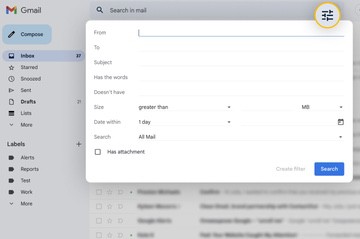

Method 2: Using Gmail settings
- Click on the gear icon located at the top right corner of Gmail.
- Click the See all settings button on top of the pop-up window.
- Go to the Filters and Blocked Addresses tab.
- Click on Create a new filter.
- In this window, you can input your desired criteria for the filter, such as sender's email address or specific keywords. Click Create filter.
- Define the actions you want to happen when the email meets your criteria.
- Click on Create Filter.
- You can view new filters (along with your other filters) under the Filters and Blocked Addresses tab.


Method 3: From an email
- Open an email from the sender for which you want to create a filter.
- Click on the three dots in the email's top right corner.
- Select Filter messages like this from the drop-down menu.
- This will open a new window with the sender's email address already filled in as a filter condition.
- You can add more criteria by clicking Create Filter and selecting the desired options.


How to create filters in Gmail mobile app
Tidying up your Gmail inbox when you set up filters on your mobile isn't as easy as doing it on a desktop.
The not-so-good news is you can't create a filter in Gmail on the go. You can't do it natively through the mobile app; not even in your device's web browser either!
This sounds strange, especially since most people these days use their Gmail on their iOS or Android devices.
The good news is there's a workaround—the inbox sorter app Clean Email can make this as easy as creating filters on the web.
Filter All Gmail Emails Automatically Using Clean Email
If you try to create filters in Gmail manually and feel it's too tedious or complex—or prefer to do it on your mobile—the Clean Email app offers a broader and more customizable filtering solution.
All Clean Email features are available and convenient on mobile for both Android and iOS (or sign up on the web). This is one of the top reasons our users prefer to clean their inbox on the go using our mobile app, rather than doing it natively through Gmail, which has limitations.
Important: Clean Email's algorithms only analyze email headers that contain subject lines, sender and recipient information, dates, message size, and similar metadata. Your data and security are safe—Clean Email never sells or shares your personal information with third parties!
Smart Folders
When you sign up for Clean Email (it’s free to try) and the app starts analyzing your Gmail inbox, it automatically applies 30+ predefined filters to your messages, grouping similar emails into easy-to-review bundles called Smart Folders.
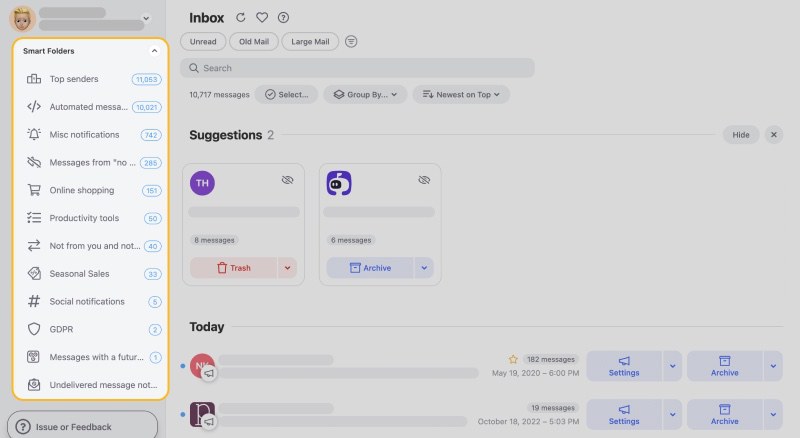
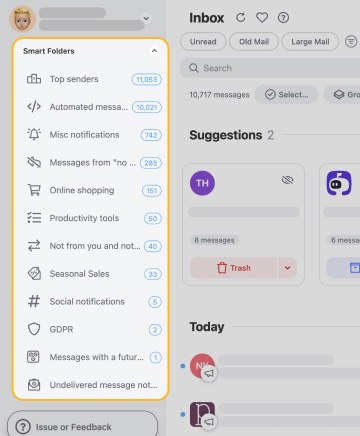
With this feature, your emails are automatically organized into folders so you can preview and manage them easily. But no worries, Smart Folders don’t change the look of your Gmail inbox; they’re just ‘labels’ for emails within the Clean Email app.
You can remove, archive, move, label, and apply other actions to your emails with a simple click. The best part is that this functionality is conveniently available on both mobile and desktop.
Simply expand Smart Folders on the left panel and choose from options such as Seasonal Sales, Social Notifications, Productivity Tools, or your Top Senders.

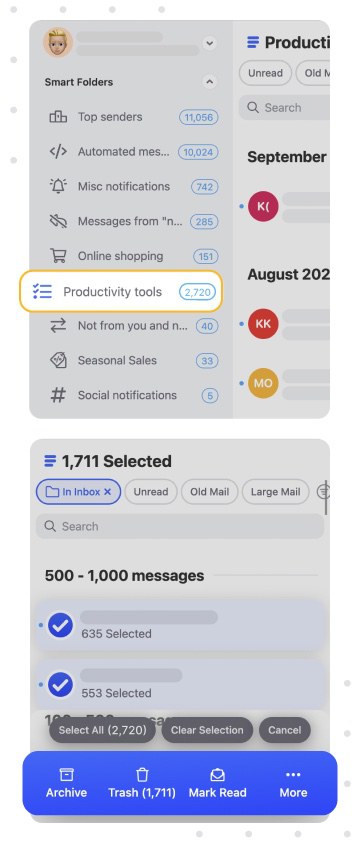
Moreover, Clean Email allows you to apply bulk actions across multiple emails with a single click. Similar to doing it on the native Gmail interface, you can go granular with your preferred conditions and actions even on mobile.
This means that in addition to organizing your inbox, you can also delete or archive large groups of emails at once.
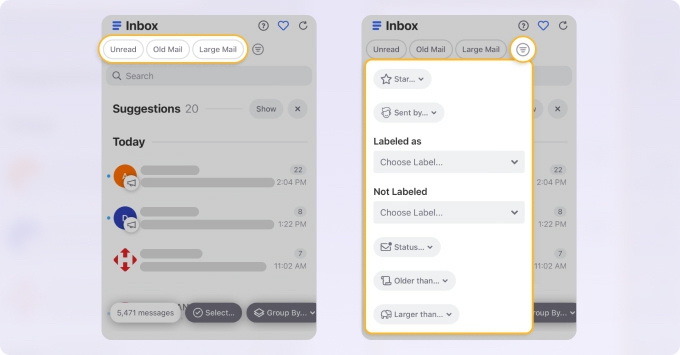
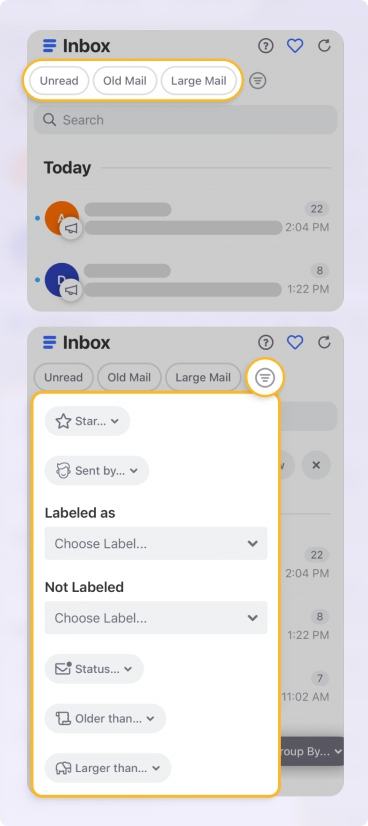
Cleaning Suggestions and Auto Clean
The Cleaning Suggestions feature learns from your behavior and offers personalized suggestions that you are more likely to choose. This flexibility and automation are designed to adapt to your email management habits.
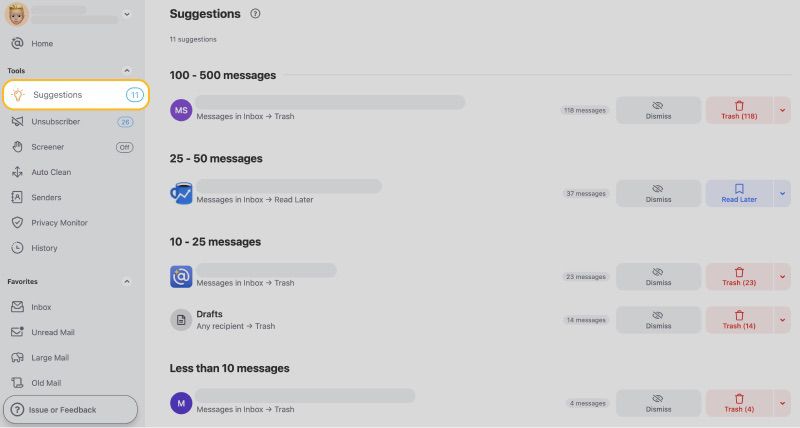

To take that adaptation even further, you can use the Auto Clean feature. With it, you can automate frequently repeated actions by creating automatic rules right from the Suggestions section. This is a great alternative to manually creating rules and actions within Gmail, as you get ideas that can be used for creating filters.
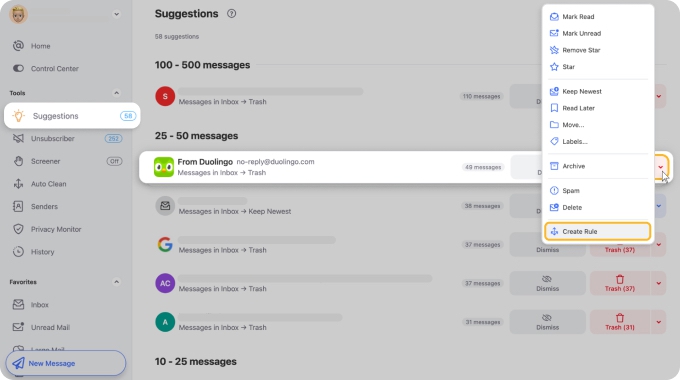
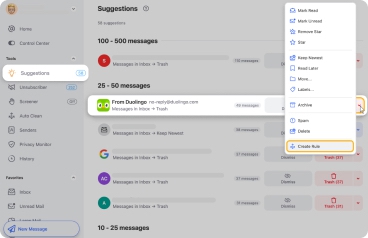
When you set up an Auto Clean rule, Clean Email will automatically apply actions to incoming and existing emails that meet your specified criteria. Just set and forget!
Example: You can create a rule to automatically mark unread promotional emails as read once they become older than 3 months.
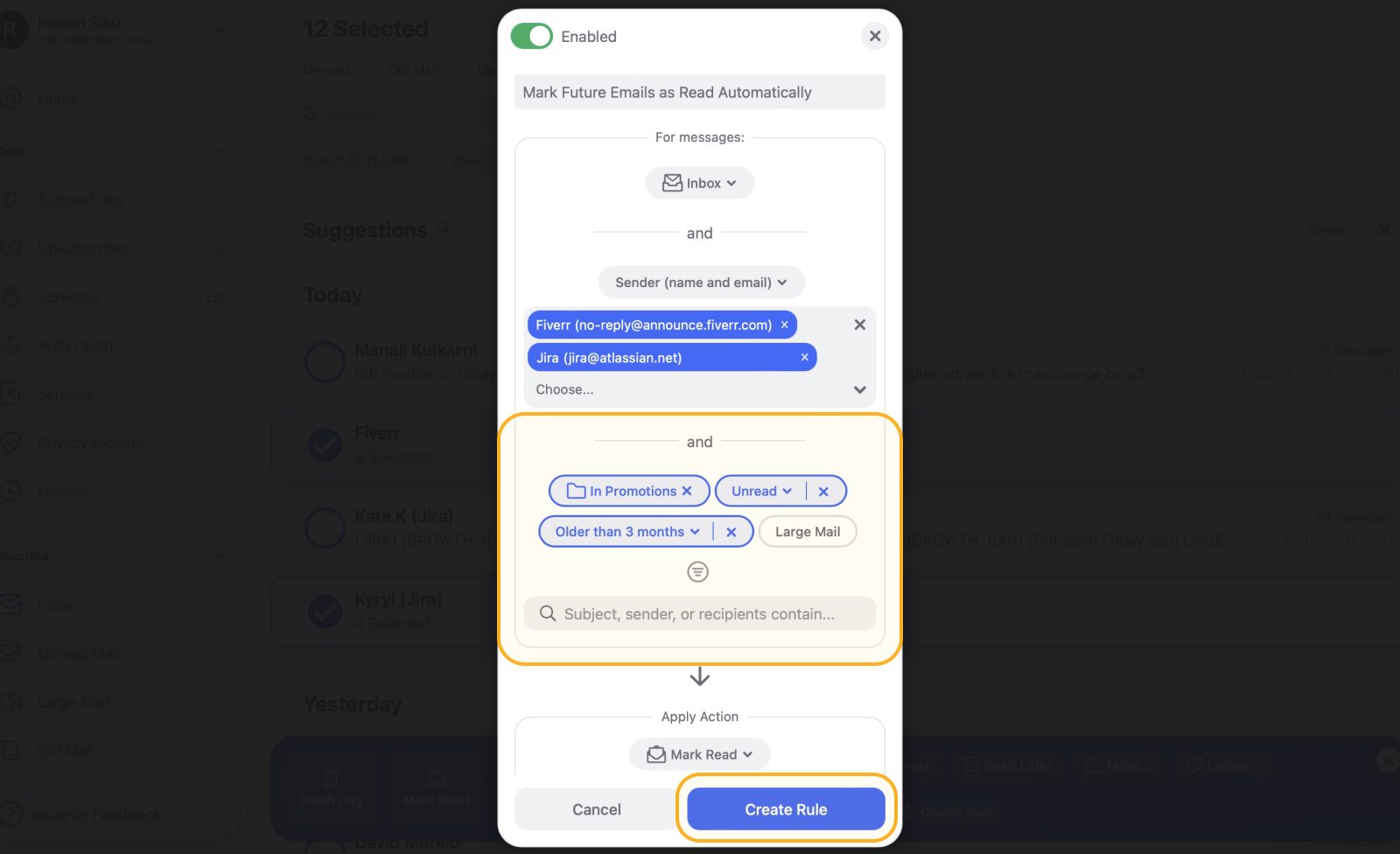
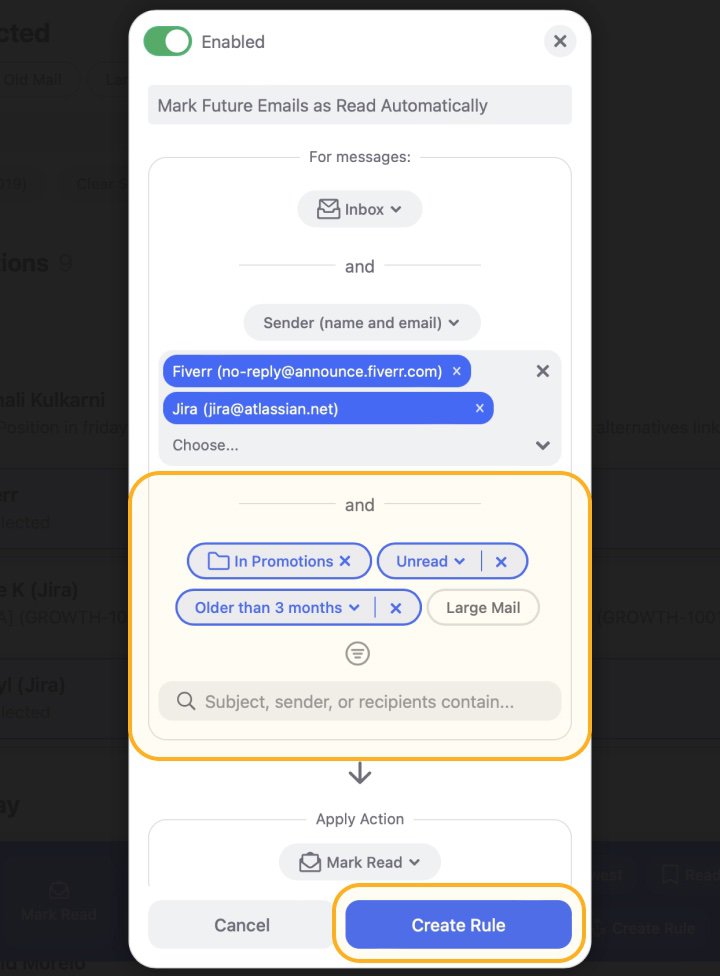
The Auto Clean rules work in the background, ensuring your inbox remains organized without any manual intervention. It's also possible to pause and restart them in the Auto Clean dashboard.
Senders
The Senders feature allows users to quickly and easily configure settings and apply filters to new and existing emails from a specific sender without having to create a rule from scratch or manually enter the sender’s address.
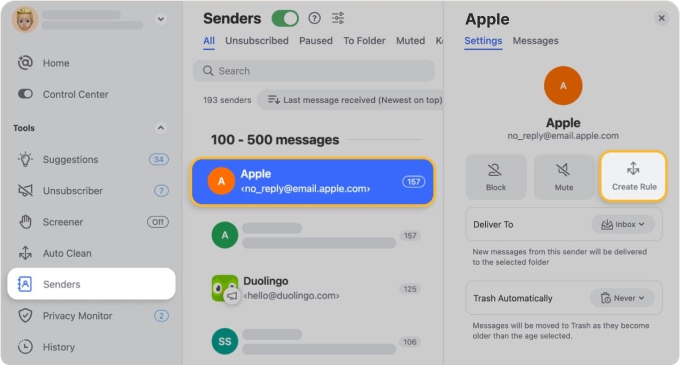
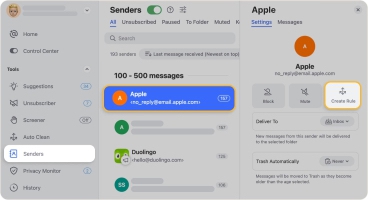
This is particularly useful for managing emails from important contacts. For instance, you can set a rule to star them, send them to a specified folder, or assign a label upon arrival.
An Overview of Gmail vs. Clean Email Filters
Here’s a brief overview of some Gmail filters and how Clean Email has a stronger solution that helps you avoid manually creating these filters.
💡 Note: While you can’t create filters in the Gmail mobile app, Clean Email’s features work seamlessly across all devices, whether you’re on the web or on your smartphone.
| Filter | How to Set in Gmail | How Clean Email Exceeds |
|---|---|---|
| Applying labels |
| Smart Folders automatically groups messages without the need for manual labels. |
| Saved email filtering views | You can create filters to auto-apply actions (label, archive, mark as read, etc.), but you can’t save custom searches or views. To see them again, you must re-enter search operators or make a new filter each time. | Favorites let you save any combination of filters, searches, sort order, and grouping as reusable views, accessible anytime from the sidebar. |
| Block new senders automatically | No direct option. You must manually block each sender one by one. | With Screener, new senders are automatically quarantined for approval. You can allow or block them all with one click. |
| Automatically filter emails by attachments |
| With the Large Mail preset filter, you can easily find and remove messages with large files. |
| Filter emails from top senders | Manually search by sender or create a filter for each individual email address. No built-in way to view top senders automatically. | The Top Senders filter automatically groups emails by your most frequent senders, making it easy to review or clean them in bulk. |
| Filter archived emails | Use the All Mail view and manually search with “-in:Inbox” to see archived messages; no dedicated filter option. | Dedicated Archive folder for instant access to all archived emails. |
| Pause and resume rules | Not available. If you want a rule to stop, you must delete it and create a new one later. |
Maintaining Your Gmail Filters
Once you create filters in Gmail, reviewing them regularly is key—especially as your email usage changes. Some of them may no longer be necessary. Or you may find new senders or keywords that must be added to existing ones. Hence, there is a need to manage filters in Gmail periodically.
Editing Existing Filters
Here's how you can edit the filters you already have in Gmail:
- Click on the gear icon in the top right corner and select See all settings.
- Click on the Filters and Blocked Addresses tab.
- Find the filter you want to modify and click edit.
- Make necessary changes in the criteria and actions.
- Save your changes by clicking on Update Filter.

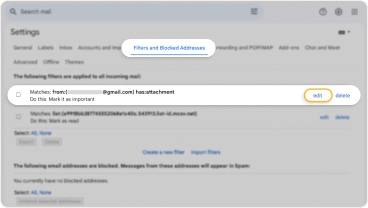


Deleting Unnecessary Filters
If you decide to get rid of existing ones, the steps are similar to editing them:
- Perform steps 1 to 3 from the above to find the filter you want to delete.
- Instead of clicking edit, go to delete.
- Click the OK button to confirm the action.

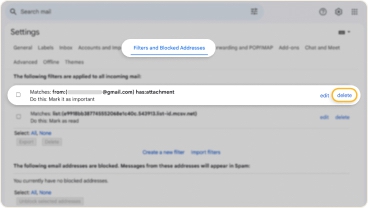
5 Common Gmail Filters for Effective Email Management
Gmail filters help you stay organized and efficient when managing your inbox. Here are some common types.
Filter 1: Separate unread emails in Gmail
One of the quickest ways to filter unread emails is by using the search bar at the top of your Gmail page.
Simply type "is:unread" (without the quotes) and press Enter. This command screens your inbox to show only the emails that are marked as unread.
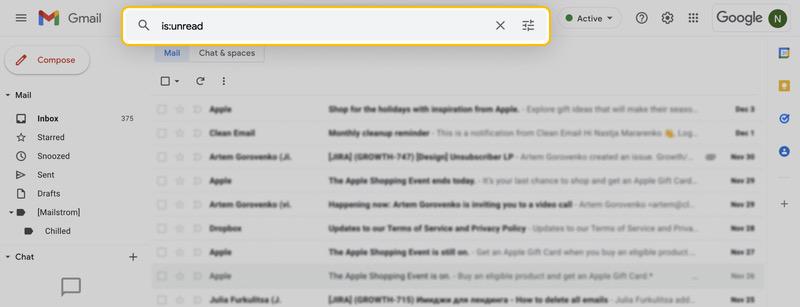
Filter 2: Move to a folder and remove from Inbox
Here's how to direct a message to a folder or label from your inbox.
- Click the Show search options icon in the search box at the top of the Gmail interface or through Settings to open the advanced search options.
- Define the criteria for the emails you want to screen. You can do this by sender, subject, keywords within the email, and more. For example, to screen all emails from "example@example.com," enter this email address in the From field.
- After entering your criteria, click the Create filter button at the bottom right of the search window.
- Choose actions:
- Apply a label: Check the Apply the label option. If you haven't created a label (folder) yet, select New label from the dropdown menu and name your label. This is where your filtered emails will go.
- Archive: Check the Skip the Inbox (Archive it) option. This action removes the message from your inbox so it only appears under the label you've assigned.
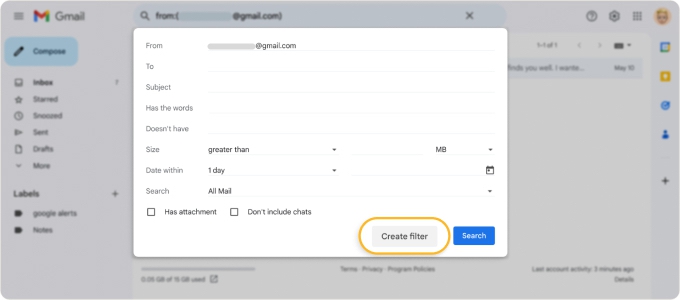
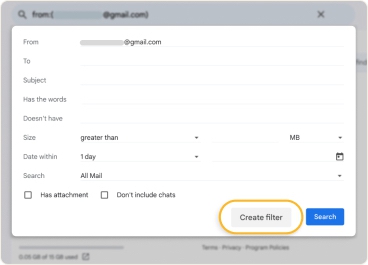
- Click on Create filter to finalize your settings.

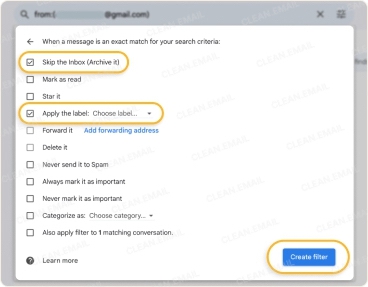
💡 Hint: For easier archiving, try Clean Email's Cleaning Suggestions to spot out the old emails and archive them with a single click.
Filter 3: Apply the same action on emails from multiple addresses
Here's how to set up a filter from multiple addresses in Gmail:
- Open the advanced search options.
- In the From field, you can specify multiple email addresses separated by commas.
- Click the Create filter button.
- Select the actions you want Gmail to take with emails that match this rule or condition. Common actions include:
- Apply the label: Choose an existing label or create a new one to organize these emails.

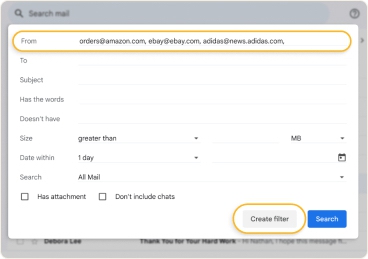
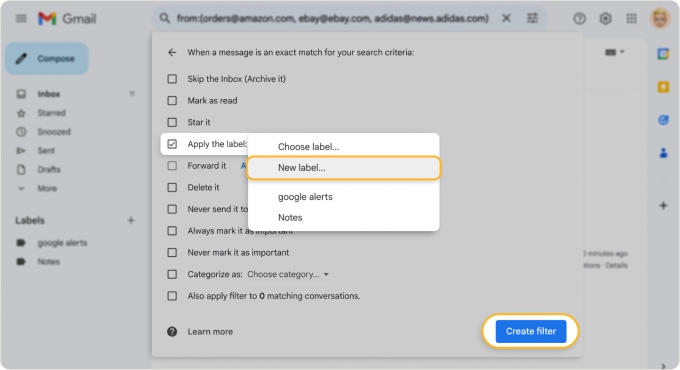

- Skip the Inbox (Archive it): To move them directly to the specified label and keep your inbox uncluttered, check this option.
- If you want to apply this filter to existing emails in your inbox that match the criteria, also check the box for Also apply filter to matching conversations.
- Click Create filter to save your new settings.
💡 Hint: You can also use Clean Email's Auto Clean feature to create a rule for various email senders at once, eliminating the need to manually type email addresses. With the app, you can select all the senders you need from any folder and create a rule for them in just a few clicks.
Any current or future emails from the specified addresses will automatically be processed according to the actions you selected, such as being labeled and removed from the inbox. This method is particularly useful for managing newsletters, notifications, or emails from specific groups of people.
Check out our guide on how to sort Gmail by sender.
Filter 4: Highlight or star important emails
Here's how to automatically highlight or star important emails:
- Open the advanced search options.
- Specify the criteria for emails you consider important. This could be based on the sender's email address, keywords in the subject line or email body, etc. For instance, to easily find all emails from your boss, enter their email address in the From field. If you want to mark emails with specific subjects as important, use the Subject field.
- After setting your criteria, click the Create filter button at the bottom right of the search window.
- Select the actions:
- Check the "Star it" option. This action automatically highlights the email by adding a star, making it stand out in your inbox.
- Check the "Always mark it as important" option. This ensures that emails meeting your criteria are classified as important by Gmail.
Alternatively, you may also want to:
- If you wish to apply this to existing emails in your inbox given they meet your specified criteria, check the box for Also apply filter to matching conversations.
- Click Create filter to save your settings.

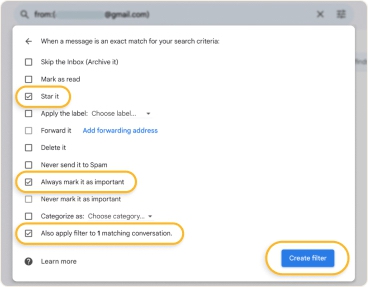
Filter 5: Set up a rule by subject
Here's how to create a rule based on the keywords a subject contains in Gmail:
- Open the advanced search options.
- In the Subject field, enter the specific words or phrases that commonly appear in the subject lines of the emails you want to screen. For instance, if you're setting up a rule for emails with the phrase "Weekly Report," you would type "Weekly Report" in the Subject field.
- Click the Create filter button at the bottom right of the search options box after entering your subject criteria.
- Now, decide what you want Gmail to do with emails that match the condition. You have several options, such as:
- Skip the Inbox (Archive it): This action moves the email out of your inbox and into the archives.
- Mark as read: Automatically marks these emails as read.
- Star it: Highlights the email by marking it with a star.
- Apply the label: Categorizes these emails under a specific label (folder). You can select an existing label or create a new one specifically for these types of messages.
- Forward it: Automatically forwards these emails to another email address (you'll need to set up forwarding first).

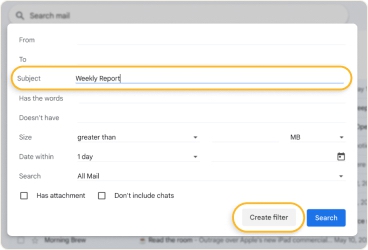
Other actions are also available, depending on how you want to manage these emails.
- If you want to apply this new one to emails already in your inbox that meet the criteria, check the box for Also apply filter to matching conversations.
- Click Create filter to save and activate your new filter.
How to Create Advanced Gmail Filters
If you receive plenty of emails in your inbox, you may want to consider more advanced Gmail filter options.
Gmail Search Operator Examples
Gmail’s search operators are words or symbols that Gmail uses to better filter your search results. Gmail supports a wide variety of search operators, including wildcard filters and regex-like filters, but we’ve listed the more common ones you’ll use in creating advanced filters:
- Gmail filter OR or { }: Find emails that match one or more of your search criteria. (from:amy OR from:David)
- AND: Find emails that match all your search criteria. (from:amy AND to:David)
- -: Create a Gmail filter that does not include certain senders or keywords. (-contact@website.com)
- " ": Search for emails with an exact word or phrase. (“deals and discounts”)
- category: Find specific emails under an inbox category. (category:primary, category:social, category:promotions)
- before or after: Filter Gmail by date to find emails sent before or after a specific day.
You can use these filters to both filter incoming mail and automatically decide what to do with it (such as deleting incoming emails filtered under the Promotions category). Alternatively, Clean Email’s Screener feature can quarantine new emails, blocking spam before it reaches your inbox.
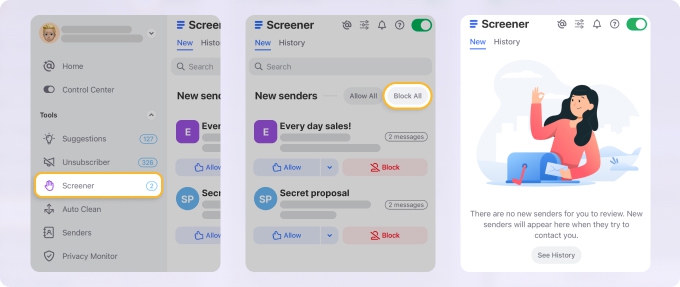

We’ve listed a few methods you can try to make your inbox more streamlined below.
Filtering by attachments
In the search box, type the Gmail filter “has:attachment” to search for all emails with attachments. You can use the Gmail filter “filename:pdf” for PDFs, Gmail filter “filename:ics” for calendar invites, or “has:image” for images. You can also use the Gmail filter “size” (e.g., “size:5mb”) to find messages larger or smaller than a specific size.
Filtering by keywords
Using the “-“ operator, you can filter emails that contain a specific keyword, like “-unsubscribe” or “-promo”. This is particularly useful when you’re trying to quickly exclude promotional messages.
Filter by category
To create category-based Gmail filters, you use the “category:” search operator, such as “category:promotions” or “category:social OR category:updates”. For an easier way to organize messages into groups, you may use Clean Email’s Smart Folders feature.
Filter by domain
You can also use the asterisk “*” search operator to filter all emails coming from a specific domain. However, this may not be practical if you apply this rule to a commonly used domain, like “@gmail.com”.
Filter by subject
Use the Gmail filter subject:”exact phrase” to target emails containing a specific phrase in the subject line.
How to Import/Export Gmail Filters
Manually creating Gmail filters can be a time-consuming process. If you have another Gmail account and wish to apply the same filters from your first Gmail account, Gmail has a native import/export feature.
Gmail: Export Filters
Here’s how you export the filters from your Gmail account:
- Click the gear icon in the top right corner of your Gmail account.
- Select See all settings.
- Go to the Filters and Blocked Addresses tab.
- Check the box next to the filters you want to export.
- Click the Export button.
- An XML file (mailFilters.xml) will be downloaded to your computer.
Gmail: Import Filters
Here’s how you can import filters into your Gmail account:
- Click the gear icon in the top right corner of your Gmail account.
- Select See all settings.
- Go to the Filters and Blocked Addresses.
- Click the Import filters option.
- Click Choose file and select the XML file you exported from your Gmail account.
- Click Open file to upload it.
- Review the filters and click Create filters to confirm the import.
How to Filter Emails in Gmail - FAQs
Why use Gmail filters?
Gmail filters can help you significantly reduce the amount of time you spend handling incoming messages. For example, you can create Gmail filters to automatically label all work-related emails accordingly, mark all emails from certain senders as spam, or forward emails from a specific contact to someone else.
How are Gmail filters different from labels?
Gmail filters and labels serve two completely different purposes. The purpose of filters is to automatically manage incoming email messages. For example, Gmail filters can be used to archive or delete emails that meet certain criteria. On the other hand, you can think of labels in Gmail as a more versatile alternative to folders. They help you keep your inbox organized by allowing you to categorize your emails.
How do I see my current Gmail filters?
To view the filters you previously created in Gmail, click the gear icon and select the "See all settings" option. Then, click on "Filters and Blocked Addresses." There, you can preview, modify, or delete your filters.
How to edit filters in Gmail?
To change filter settings in Gmail, go to the "Filters and Blocked Addresses" tab. Locate the filter you want to edit and click "edit" next to it. Make your changes and save the updated filter.
How to filter emails in Gmail using Clean Email?
To filter emails efficiently in Gmail using Clean Email, go to https://app.clean.email and sign in to your mailbox. Select the desired Smart Folder in the left pane. Choose any email sender or all of the messages in this Smart Folder group. Click "Create Rule" at the action panel and specify the rule's criteria for how to filter incoming messages matching the rule. Click "Create Rule" again, and the filter is set.


